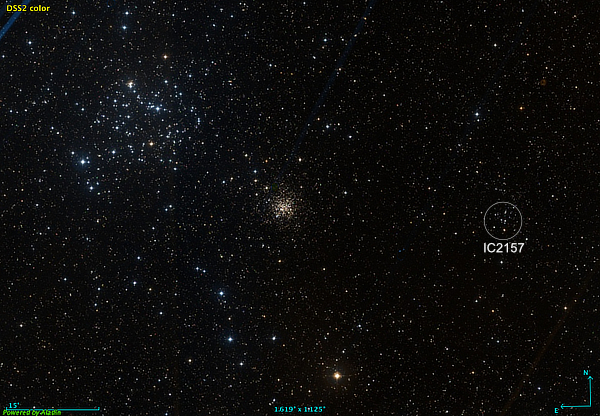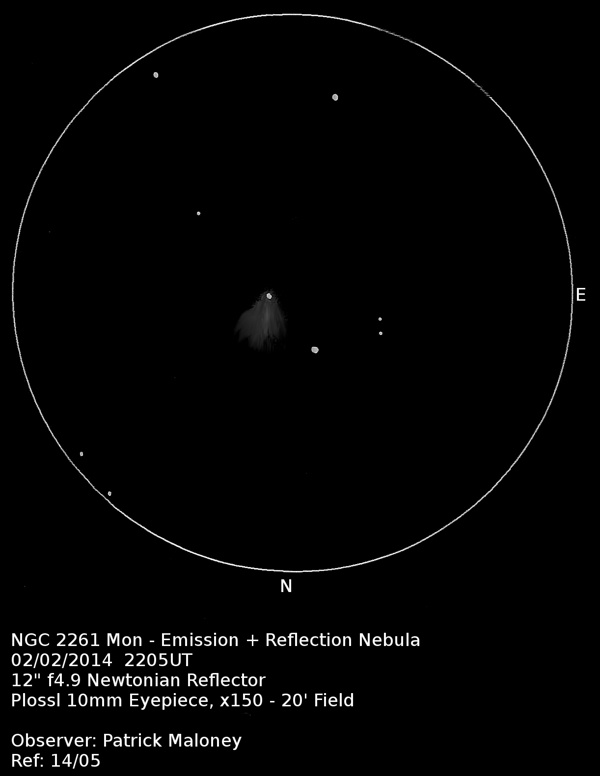Four Open Clusters and a Variable Nebula
January 2021 - Nebula and Cluster of the Month
I am writing this on the day that the first people in the UK are receiving the COVID-19 vaccine, so it is with some optimism that I wish you a very Happy New Year!
To break in the New Year, I’m going to look at an interesting chain of open clusters in Gemini and an always-fascinating nebula in Monoceros.

In about 1746, the Swiss mathematician and astronomer Philippe de Chéseaux wrote a letter to his grandfather in which he gave a list of 20 truly nebulous stars
. This list was read out at a meeting of the French Academy of Sciences in August 1746 but was never published. Number 12 on this list was described as being above the northern feet of Gemini
, which although vague by modern standards is almost certainly the first known mention of the open cluster later to be immortalised as Messier 35.
Charles Messier made his observation of the cluster on 30th August 1764, when he described it as A cluster of very small stars near the left foot of Castor; a little distance from the stars mu and eta of that constellation.
M35, or NGC 2168, is a real showcase open cluster. Its integrated magnitude is 5.1, making it an easy binocular object. It spans a diameter of 25’ and contains, according to Archinal & Hynes, 434 stars, the brightest of which is magnitude 8.0. Twenty of these stars are brighter than magnitude 10, giving a magnificent view on low power. Most of the stars are white, being of spectral classes B and A, but two of the brightest stars are of class G and K.
My most recent observation of the cluster reads A very large and bright cluster of mostly moderately bright stars, splashed all over a low power field. Very rich. Two of the brightest stars mark the beginning and end of a long, slightly curving chain of stars that is to me the defining feature of this lovely cluster. Hundreds of stars.
Located 25’ south-west of M35, and in the same low-power field, lies our second cluster. NGC 2158 is a huge contrast to its more famous neighbour.
It was discovered by William Herschel on 16 November 1784. He described it as A very rich cluster of very compressed and extremely small stars. 4 or 5’ diameter. A miniature of [Messier 35]…
He entered it as no. 17 in his class VI – Very compressed and rich clusters of stars. This was the class in which he placed eight of his globular cluster discoveries and indeed NGC 2158 looks much like a faint, loose globular. It contains around 1000 stars and has an overall magnitude (according to Archinal & Hynes) of 8.6, although my own experience of this cluster suggests that this is overly optimistic. There are 20 stars brighter than magnitude 14, and on a good night, 2158 looks like a little pin cushion, with tiny twinkles amongst the background of unresolved, fainter stars.
In a small telescope or on low power, it appears as a small, oval nebulous patch attached to a star of magnitude 10.6. Despite appearances, NGC 2158 is much richer than M35, though it lies 5 or 6 times further away, at around 13000 light-years. It is one of the most distant open clusters which can be seen relatively easily with a modest telescope.
Swing your telescope a further 35’ west of NGC 2158 and you will come across a third open cluster. IC 2157 is a small and relatively unimpressive cluster and again shows marked differences to the previous clusters. It was passed over unrecognised by William Herschel and had to wait until 1899 to be recognised by Thomas Espin. Discovered too late to be included in the NGC, it finally appeared in the Second Index Catalogue in 1908. The description in the IC is stark; Cluster, small
.
It is actually much easier to see than NGC 2158, with its brightest stars being of magnitudes 10 to 12. My observation reads A small, compact cluster of faint stars, shaped like a bow tie. Although small and faint, it is clearly visible in the 25mm eyepiece (x60). 4' or 5' diameter.
Finally, a slightly controversial one. Just 6’ north of IC 2157 lies another little group of stars which looks very much like it. Again discovered by Espin in 1899, this group is usually considered an asterism and is plotted on very few atlases. It bears the catalogue number IC 2156. I wrote this when I saw it: In the same x150 field as IC 2157. Very similar; small, moderately compressed. Eleven stars counted. Interesting to see two such similar objects in the same field, one a real cluster and the other an asterism. I can't tell the difference just by looking.
For our nebula this month, we’re going to look at that ceaselessly fascinating object, NGC 2261, better known as ‘Hubble’s Variable Nebula’.
It hardly needs saying, but it was discovered by William Herschel on Boxing Day, 1783. He placed it in his fourth class (planetary nebulae) as no. 2, describing it as Considerably bright. Fan-shaped, about 2’ long from the centre.

This object has the unique distinction of being the subject of the first photograph taken with the new 200” telescope on Mount Palomar on 26 January 1949, by Edwin Hubble himself. The nebula is famous, as its name implies, for being somewhat variable in nature. Images strung together to make animations show dark blobs moving across the nebula, from the bright point at the tip (R Monocerotis) up towards the sides and ends of the 'fan'. What we are seeing here is a shadow-play. The star which lights the nebula is the variable star R Mon, classed as a T Tauri. T Tauri stars are very young, pre-main sequence stars that have not yet begun hydrogen fusion. They are of solar mass and it is believed that the sun was probably a T Tau star in its infancy. They are associated with dense molecular clouds, and it is these clouds, spinning around the star which cast the shadows on the nebula. The prototype star, T Tau itself, is also associated with a variable nebula, NGC 1555 or 'Hind’s Variable Nebula'.
The shadow-play visible in animations takes place on the timescale of days or weeks, and generally, these variations are too subtle to be followed visually, but differences can be seen visually over longer periods. In 2013, I noted that the brightest portion of the nebula was a bright streak down its centre. In an observation made in 2001, I wrote that the eastern edge of the nebula was the brightest section.

NGC 2261 is not a difficult object to observe and should be visible in a 6” (150mm) telescope under good conditions without too much of a problem. The fan shape is immediately obvious. If you look at this object, take a careful note of its appearance – or better still, make a drawing. Then go back to it next year and compare your view. It is very dramatic to observe for yourself a deep-sky object that actually changes its appearance over such short timescales.
| Object | RA | Dec | Type | Magnitude |
|---|---|---|---|---|
| IC 2157 | 06h 04m 50s | +24° 03’ 18” | Open cluster | about 10 |
| IC 2156 | 06h 04m 53s | +24° 09’ 37” | Asterism | about 10 |
| NGC 2158 | 06h 07m 26s | +24° 05’ 40” | Open cluster | 8.9 (?) |
| M 35 | 06h 09m 03s | +24° 21’ 16” | Open cluster | 5.1 |
| NGC 2261 | 06h 39m 10s | +08° 44’ 51” | Reflection nebula | about 11 |